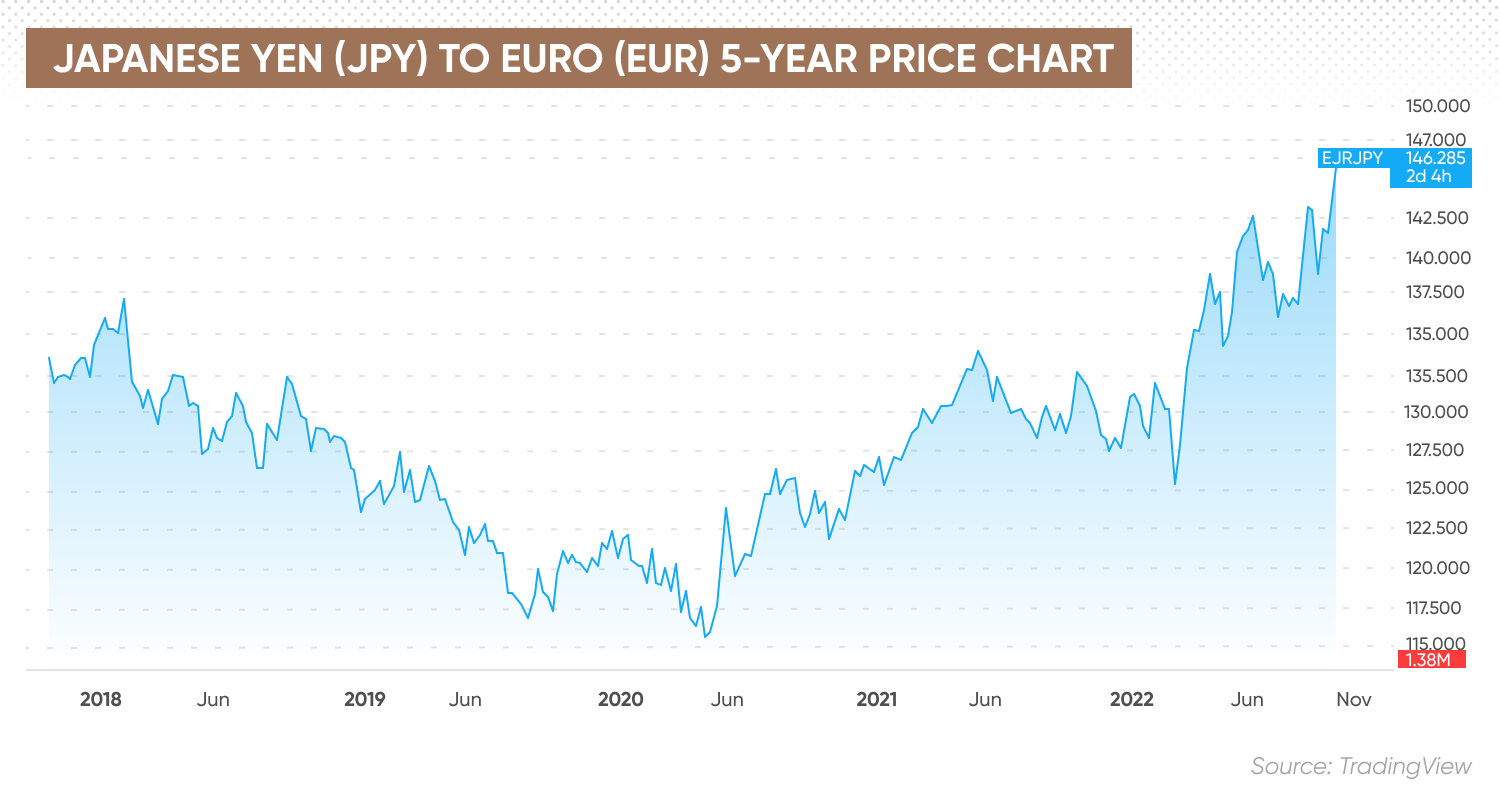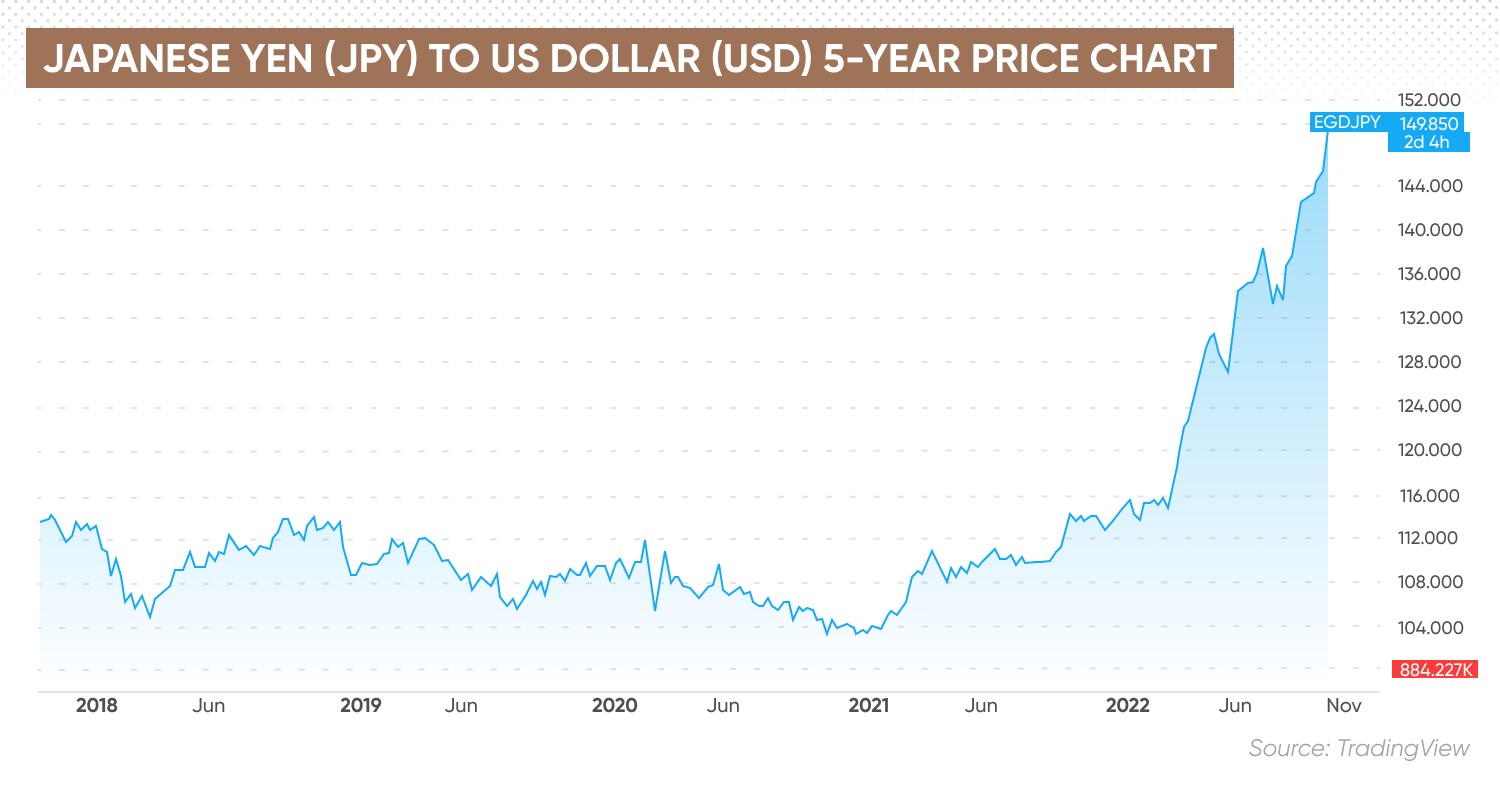Japanese yen forecast: JPY hits two-decade lows as BoJ vows to maintain loose monetary policy
The Japanese yen has weakened against both the euro and the US dollar, is a rebound possible?
The Japanese yen (JPY) is weakening sharply against other currencies such as the US dollar (USD) and euro (EUR) as interest rate differentials rise and capital flows out of the yen into other assets.
The JPY has been the worst performing currency of the G10 nations year-to-date (YTD) against the USD.
USD/JPY live price chart
The yen has dropped to its lowest level against the dollar since 1990, resulting in Japan’s finance ministry intervening in the foreign exchange market for the first time since 1998. Will that be enough to support the currency, or will the yen fall further?
In this article we look at the drivers for the yen’s strong depreciation and the latest JPY predictions from forex analysts.
What drives the yen’s value?
Introduced in 1871, the Japanese yen is the official currency of Japan, issued by the Bank of Japan (BoJ).
The yen is the world’s third most-traded currency, behind the US dollar and the euro. It has been considered a safe-haven asset and used extensively by forex investors in the ‘carry trade’ – borrowing money in yen and investing it in other countries with higher interest rates.
The Japanese government has historically had a policy of near-zero interest rates and currency intervention, keeping the value of the yen relatively low to maintain a competitive export market.
This policy has seen the yen weaken to its lowest levels in years against currencies such as the US dollar, euro and British pound (GBP).
JPY drops to 32-year low against USD
The yen is fast approaching the 150 level against the US dollar, having surpassed a two-decade low at 134 and then the psychologically important 145 mark earlier this month.
The USD/JPY exchange rate started 2022 at $115.32 and traded around the $115 level until March, when the US Federal Reserve (Fed) began raising interest rates with a 0.25 basis point (bp) hike.
By early May, the pair was trading at 130, as the Fed announced a 50bp hike. There was a brief retreat later in the month, when USD/JPY traded below 127, but the pair began to climb again in June with the first of three 75bp hikes to date.
The pair traded up to 138.94 on 14 July, retreated to 131.61 on 1 August but then accelerated its rally. It reached 149.79 on 19 October, its highest level in 32 years.
With US interest rates and the value of the dollar rising rapidly, central banks in Asia have begun intervening in the currency markets. The Bank of Japan has been the most aggressive, purchasing nearly $20bn in the forex market in September as the USD/JPY rate climbed to 145.
The pair reached the 145 level after a surprisingly positive US jobs report increased the possibility that the Fed will continue to aggressively raise interest rates to slow down the overheating US economy.
Analysts at Hong Kong-based bank HSBC noted on 17 October that the yen has weakened past the level at which Japan’s Ministry of Finance (MoF) intervened in the market in September, “creating a dilemma”, adding:
The yen has also weakened against the euro, with the EUR/JPY pair trading up to 147, its highest level since 2008. The European Central Bank (ECB) has raised interest rates out of negative territory, with further hikes expected to come. The EUR/JPY rate started the year at 130 but after dipping to 125.21 in early March, climbed above 140 in June. The pair retreated to 135.40 in early August but climbed to 144.57 in September and reached 147.14 on 18 October
What is the outlook for the yen for the rest of 2022 and in the coming years? Will it continue to shed value or rebound against the dollar and euro? Let’s look at some JPY forecast analyses.
JPY forecast: Will the yen remain an underperformer?
Analysts at French investment bank BNP Paribas downgraded their JPY forecast, noting:.
According to the latest Japanese yen forecast from Bjørn Tangaa Sillemann, senior analyst at Danske Bank in Denmark: “The key driver of USD/JPY remains the global inflation outlook and US treasury yields. With the US labour market still in good shape, we are not convinced global inflation pressures are yet turning and thus, in the short run, JPY headwinds will remain in place. Looking further ahead, we do expect the pressure on JPY will wear off. We forecast the cross at 145.0 (1M), 145.0 (3M), 139.0 (6M) and 130.0 (12M).”
| USD/JPY forecast | Q4 2022 | Q1 2023 | Q2 2023 | Q3 2023 | Q4 2023 | Q1 2024 | Q2 2024 | Q3 2024 | Q4 2024 |
| AIB | 148 | 149 | 148 | - | - | - | - | - | - |
| CIBC | 140 | 138 | 136 | 135 | 130 | - | 127 | - | 124 |
| Danske Bank | 145 | 139 | - | 130 | - | - | - | - | - |
| DBS | 150 | 145 | 141 | 136 | - | - | - | - | - |
| Hong Leong Bank | 147 | 146 | 145 | 144 | - | - | - | - | - |
| ING | 148 | 148 | 145 | 143 | 140 | 138 | - | - | 130 |
| Maybank | 145 | 145 | 140 | 135 | - | - | - | - | - |
| Mizuho | 143 | 140 | 135 | 130 | - | - | - | - | - |
| Monex | 145 | 135 | - | 125 | - | - | - | - | - |
| National Australia Bank | 145 | 135 | 130 | 125 | 121 | 119 | 117 | 115 | 114 |
| National Bank of Canada | 146 | 140 | 132 | 125 | - | - | - | - | - |
| Scotiabank | 140 | 138 | 138 | 133 | 133 | 130 | 130 | 130 | 130 |
| SEB Group | 150 | 144 | 138 | 131 | - | - | - | - | - |
| Societe Generale | 145 | 140 | 135 | 130 | 125 | - | - | - | - |
| Westpac | 140 | 138 | 136 | 134 | 132 | 130 | 128 | - | - |
“With the BoJ showing no signs of abandoning its ultra-loose monetary policy stance and widening rate differentials set to keep pressure on the yen, we see USDJPY grinding higher in the near-term, albeit at a reduced rate due to unilateral intervention efforts,” analysts at currency exchange firm Monex wrote in their most recent JPY forecast.
“Over the medium term, we expect the BoJ to exit its ultra-loose policy stance, prompting a substantial capital inflow and a strong rally in the yen. In the near-term, rising recession risks and the pressure that will have on US rates poses a downside risk to our USDJPY forecasts, with the yen potentially regaining its status as a haven currency. Conversely, upside in US rates may have the same effect as it could bring forward the Bank of Japan’s plans to normalise policy should its reserves start to deplete at a rapid pace.”
In its Japanese yen prediction, HSBC also saw the potential for the yen to turn higher, stating “we believe that USD-JPY is close to peaking and would correct modestly at the end of the year and further in 2023”.
Similarly, Malaysia-based Maybank stated:
French bank Societe Generale forecast that the USD/JPY pair could gradually trend lower over the coming years. The bank’s JPY forecast for 2025 has the pair averaging 110.
| EUR/JPY forecast | Q4 2022 | Q1 2023 | Q2 2023 | Q3 2023 | Q4 2023 | Q1 2024 | Q2 2024 | Q3 2024 | Q4 2024 |
| AIB | 142 | 148 | 151 | - | - | - | - | - | - |
|
Dankse Bank |
139 | 132 | - | 121 | - | - | - | - | - |
| ING | 136.16 | 136.16 | 137.75 | 140.14 | 140 | 140.76 | - | - | 143 |
| Mizuho | 139 | 143 | 140 | 138 | - | - | - | - | - |
| SEB Group | 145 | 144 | 139 | 137 | - | - | - | - | - |
| Societe Generale | 140.70 | 140 | 139.10 | 139.10 | 140 | - | - | - | - |
| Westpac | 143 | 144 | 146 | 147 | 148 | 148 | 147 | - | - |
Against the euro, the JPY forecast for 2022 from analysts ranged between 136.16 from Dutch bank ING and 145 from Swedish financial services firm SEB Group. Analysts tend to expect the EUR/JPY pair to move higher in the first quarter. But over the long-term Dutch bank ING expects the pair to reach 143 by the end of 2024 from 136.16 at the end of 2022.
At the time of writing (19 October), AI Pickup’s JPY forecast for 2030 showed the pair climbing to 167.78 from 125.98 in 2025 and 121.40 in 2023.
Note that analysts’ predictions can be wrong. Forecasts shouldn’t be used as a substitute for your own research. Always conduct your own due diligence before trading. And never invest or trade money you cannot afford to lose.
Stay up to date with the major forex pairs using our currency strength meter.
FAQs
Is JPY a good investment?
Whether the Japanese yen is a suitable investment for your portfolio will depend on your risk tolerance, portfolio composition and investing approach. Always conduct your own due diligence before trading. And never invest or trade money you cannot afford to lose.
Will JPY go up or down?
The direction of the Japanese yen against other currencies could depend on the Japanese government’s monetary policy and any further interventions in the currency market, as well as the US Federal Reserve’s policy on interest rates.
Should I invest in JPY?
You should do your own research to decide whether or not to invest in the Japanese yen. Always conduct your own due diligence before trading. And never invest or trade money you cannot afford to lose.
